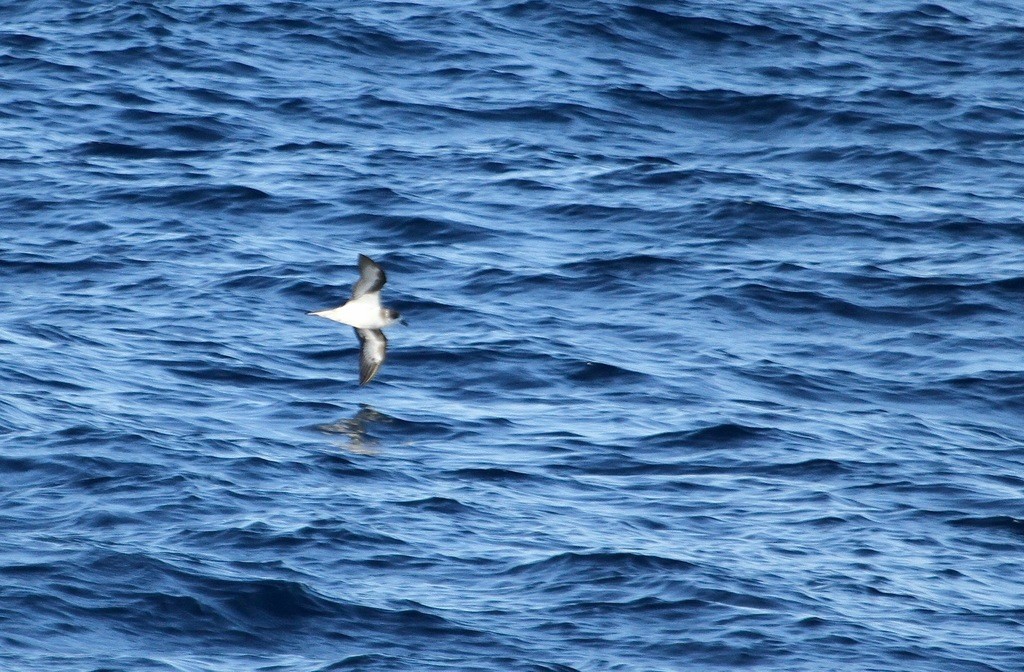Bermuda Petrel
A species of Gadfly Petrels Scientific name : Pterodroma cahow Genus : Gadfly Petrels
Bermuda Petrel, A species of Gadfly Petrels
Botanical name: Pterodroma cahow
Genus: Gadfly Petrels
Content
Description General Info
 Photo By wsweet321 , used under CC-BY-NC-4.0 /Cropped and compressed from original
Photo By wsweet321 , used under CC-BY-NC-4.0 /Cropped and compressed from original Description
The Bermuda petrel (Pterodroma cahow) is a gadfly petrel. Commonly known in Bermuda as the cahow, a name derived from its eerie cries, this nocturnal ground-nesting seabird is the national bird of Bermuda and can be found pictured on Bermudian currency. It is the second rarest seabird on the planet and a symbol of hope for nature conservation. They are known for their medium-sized body and long wings. The Bermuda petrel has a greyish-black crown and collar, dark grey upper-wings and tail, white upper-tail coverts and white under-wings edged with black, and the underparts are completely white. For 300 years, it was thought to be extinct. The dramatic rediscovery in 1951 of eighteen nesting pairs made this a "Lazarus species", that is, a species found to be alive after having been considered extinct. This has inspired a book and two documentary films. A national programme to preserve the bird and restore the species has helped increase its numbers, but scientists are still working to enlarge its nesting habitat on the restored Nonsuch Island. 
Size
23 - 41 cm
Nest Placement
Burrow
Feeding Habits
Bermuda Petrel predominantly consumes squid and shrimp, foraging nocturnally at sea. They have specialized hunting techniques that likely involve diving and surface seizing. Bermuda Petrel exhibits unique adaptations for a pelagic lifestyle, allowing them to exploit these specific marine resources efficiently.
Habitat
Small offshore islets exclusively, burrows, the end of tunnels, artificial burrows, pelagic environments
Dite type
Piscivorous
General Info
Feeding Habits
Bird food type
Species Status
David B. Wingate devoted his life after that to saving the bird. After university studies and other work, in 1966 Wingate became Bermuda's first conservation officer. He undertook work to address various threats to the Bermuda petrel, including the eradication of introduced rats on the nesting islands and nearby islands, and addressed nest-site competition with the more aggressive, native white-tailed tropicbird Phaethon lepturus catsbyii, which invaded petrel nest burrows and killed up to 75% of all chicks. Following the design and installation of specially sized wooden "baffler" burrow entrance covers, which allowed the petrels to enter but excluded the larger tropicbirds, there has been essentially no further chick loss from this cause. Wingate also initiated the ecological restoration of Nonsuch Island, located near the Bermuda Petrel breeding islets. Nonsuch was a near desert after centuries of abuse, neglect and habitat destruction. The measures that had to be taken weren't just for conserving what was left but also to recreate what had been lost, and thousands of endemic and native plant, including Bermuda cedar (Juniperus bermudiana), Bermuda palmetto palm (Sabal bermudana) and Bermuda olivewood (Cassine laneanum), were propagated and planted out on Nonsuch to recreate the original forest ecosystem that once covered Bermuda, but which was almost entirely lost through disease and clearing for agriculture, shipbuilding and residential development. In total, almost 10,000 individual native and endemic plants of over 100 species were planted on Nonsuch starting in 1962, and have since developed into a well-established closed-canopy forest, similar to early accounts of what was found on Bermuda by the earliest settlers in the 1600s. Wingate's goal was to restore the habitat on Nonsuch Island so that it could eventually serve as a viable nesting site for the species. Even after retirement, Wingate designed and donated artificial plastic nest boxes to the Cahow Recovery Project, funded by the Bermuda Audubon Society. These nests were an effort made toward assisting the recovery of the Bermuda Petrel, which normally nest in deep soil burrows or rock crevices but suffered from a shortage of suitable nest sites and soil for the birds to burrow in on the original nesting islets. Artificial concrete burrows have been used for many years to provide additional nesting opportunities for the birds, but are very labor-intensive to construct, requiring 400-800 lbs of concrete each. The new nest boxes were designed to meet the birds nesting needs, and it is hoped that they will assist in the recovery of the Cahow for its future survival. David Wingate retired in 2000, after which Jeremy Madeiros became the Bermuda Government terrestrial conservation officer, taking over the management of the Cahow Recovery Program and the Nonsuch Island Living Museum Project. Madeiros carried out a review of the status of the Bermuda Petrel, identifying erosion of the four small original nesting islets due to hurricane damage and sea-level rise as the single largest threat facing the species. A banding program for both fledgling and adult Petrels was initiated in 2002, and by 2015 had resulted in over 85% of all Bermuda Petrels being fitted with identification bands, enabling positive identification of individual birds through their breeding lifespan. Madeiros published a recovery plan for the Bermuda Petrel, which provided guidelines and objectives for the management of the species, in 2005. 
Scientific Classification
Phylum
Chordates Class
Birds Order
Albatrosses and Petrels Family
Shearwaters and petrels Genus
Gadfly Petrels Species
Bermuda Petrel